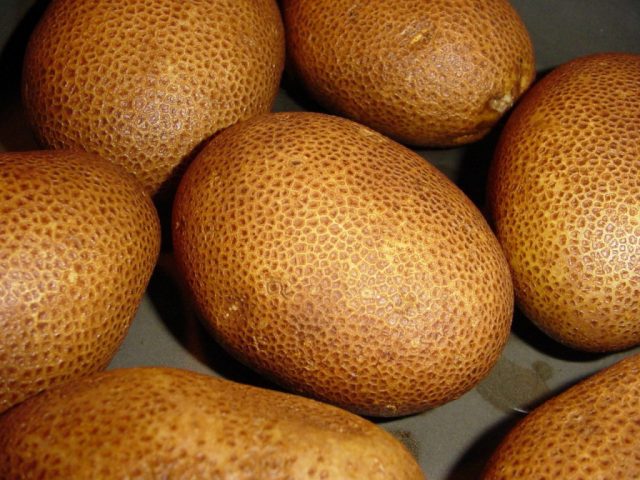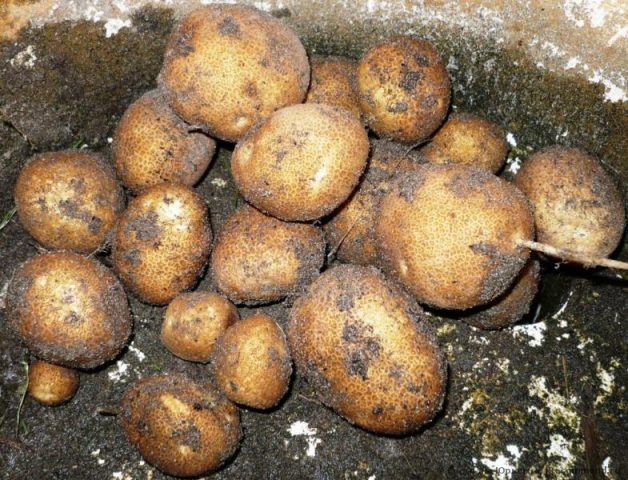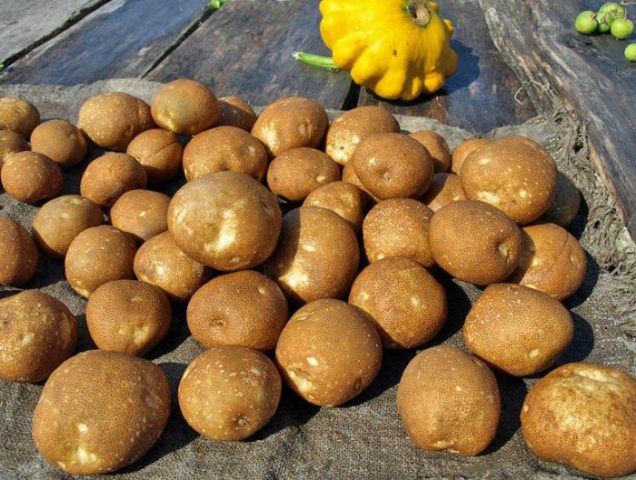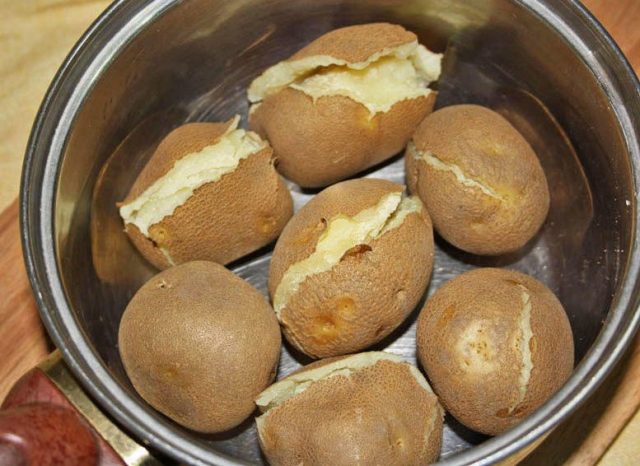Content
The Kiwi variety is an unusual potato that is gaining popularity among gardeners. It is planted in various regions, appreciated for its original appearance and good taste. Below is the characteristics of the Kiwi potato variety and reviews on it, as well as the rules for planting and care.
Description of kiwi potato variety
Kiwi potatoes were bred in the 90s of the XX century. in the city of Zhukov, Kaluga region. The variety belongs to the amateur, did not pass state tests and therefore there is no information about the hybrid in the State Register of the Russian Federation.
When studying the description of the Kiwi potato variety, gardeners are interested in the question of whether it is GMO or not. This is due to its high resistance to the Colorado potato beetle. In laboratory conditions, plants are obtained that are resistant to pests and diseases. First, the genes responsible for the desired properties are separated, then special bacteria are introduced into the potato cell.
All GMO products are tested and labeled. The sale of 5 genetically modified potato varieties is allowed in Russia. Among them, the Kiwi variety is absent.
According to the description of the variety and the photo, Kiwi potatoes ripen at a later date. The period from germination of tubers to harvest takes an average of 125 days. This period of time is influenced by soil moisture and weather conditions.
Kiwi bushes reach a height of 50 - 80 cm. The shoots are erect, with a large number of branches. The bushes are well leafy. The leaf plate is elongated, rough, serrated along the edges. The color is bright green. The flowers are lush, deep purple.
Characteristics and photos of the Kiwi potato variety:
- elongated shape;
- rounded edges;
- mesh rough peel;
- white firm flesh.
The hybrid got its name due to the similarity of root crops with kiwi. At the same time, the potatoes have approximately the same size: medium and large. Small specimens practically do not come across. Kiwi potato tubers are rich in fiber and dry matter.
Taste qualities of kiwi potatoes
According to the characteristics of the variety and reviews, the taste of Kiwi potatoes is rated as average. Tubers are used in cooking. The flesh of the potato is boiled and becomes crumbly. The cooking period is 40 minutes. Compared to other varieties, Kiwi potatoes require more processing time.
Kiwi variety is not used for roasting. Due to the dry matter content, the potatoes burn. Therefore, the harvest is used to obtain salads, first and second courses.
Pros and cons of the variety
Key benefits of Kiwi potatoes:
- high productivity;
- unpretentiousness to the place of cultivation;
- long storage period;
- resistance to disease.
Disadvantages of the Kiwi variety:
- average taste;
- difficult to find on sale;
- limited use.
Planting and caring for Kiwi potatoes
Compliance with the rules of planting and care will help to get a high yield of Kiwi potatoes. Although the variety is considered unpretentious, soil fertility, hilling and watering positively affect its development.
Selection and preparation of the landing site
Kiwi potatoes are planted in a sunny area.The crop prefers neutral soils, but grows on acidic soils. For growing the Kiwi variety, light or medium soil is best suited: loam, black soil, sandy loam. If the soil is clayey on the site, the tubers will not be able to fully develop.
The plot for potatoes is located from north to south. For planting, a lowland is not suitable, where water and cold air accumulate. With an excess of moisture in the soil, the risk of spreading diseases increases.
The best crop precursors are cucumber, cabbage, beets, herbs. If tomatoes, potatoes, peppers or eggplants grew in the beds, it is recommended to change the planting site. They begin to prepare the soil in the fall. The site is dug to a depth of 30 cm. The soil is cleared of weeds, fertilized with compost and wood ash.
Preparation of planting material
It is important to prepare the material before planting. This will increase the yield of the crop and avoid diseases. For planting, tubers weighing 80 - 100 g are selected. Too small specimens will not work, since they will not be able to give a good harvest.
For 1 - 1.5 months before disembarkation, the material is transferred to a lighted place. The tubers are germinated at a temperature of +12 ° C. Root crops with sprouts 1 cm long are planted in the ground.
Before starting work, Kiwi potatoes are treated with a growth stimulator. Apply drugs Epin or Zircon. For 1 liter of water, 20 drops of the drug are required. Tubers are sprayed from a spray bottle. Processing stimulates the growth of potatoes, increases their resistance to diseases and weather conditions.
If the planting material was purchased from hands, then it is better to additionally process it before planting. The tubers are dipped in a 1% boric acid solution. The exposure time is 20 minutes.
Landing rules
They start planting potatoes when the soil warms up well. The timing depends on the climatic conditions in the region. This is usually the period from late April to mid-May. The tubers are planted in moist soil. The planting depth is chosen taking into account the composition of the soil. On clay soils - no more than 5 cm, in sandy soils - 12 cm.
The order of planting potatoes of the Kiwi variety:
- Holes or furrows are dug on the site. Between the tubers they are kept 30 - 40 cm, between the rows - 70 cm.
- A handful of wood ash is placed in each recess.
- The tubers are dipped into the holes.
- The potatoes are covered with earth.
In addition to the traditional method, other planting options are gaining popularity. One of them is to spread the tubers in the garden and cover them with a thick layer of straw. More straw is added as the bushes grow. The advantages of this method are the quality of root crops and ease of harvesting. However, potatoes can suffer from a lack of moisture and become food for rodents.
Watering and feeding
Moisture intake has a positive effect on the development of potatoes. Until buds form, the culture is not watered. Then the soil is kept moist. First you need to make sure that the soil is 10 - 12 cm dry. Water the potatoes in the evening. The rate of water per bush is 2 liters.
The potatoes are fed as needed. Organics and minerals are laid when planting or digging up the soil. On poor soils, additional feeding is required.
For culture, slurry, herbal infusion, a solution of urea or ammonium nitrate are used. Fertilizers contain nitrogen, which contributes to the growth of green mass. This feeding is carried out in June. After 3 - 4 weeks, superphosphate or wood ash is added to the soil.
Loosening and weeding
For the successful cultivation of potatoes, it is important to periodically weed and loosen the soil. Weeds are removed as they emerge from the soil. The procedure is convenient to perform with a rake.
The first loosening is carried out before the emergence of shoots. Subsequently, the soil is loosened after rain or watering.It is important not to allow a crust to form on the surface of the earth. As a result, air exchange in the soil improves, plants absorb moisture and nutrients better.
Hilling
Hilling is another mandatory step in crop care. Processing stimulates the emergence of new stolons, on which the harvest is formed. When hilling under the base of the bush, shovel the soil from the rows.
Potatoes are spud twice during the season. The first time is when the bushes reach 15 - 20 cm in height. Subsequent - 3 weeks before flowering. Hilling is performed after watering or rain.
Diseases and pests
The potato variety Kiwi is highly resistant to diseases and pests. Plants are not susceptible to late blight, rot, phomosis, fusarium wilt. Good disease prevention is compliance with agricultural techniques and planting dates. Choosing healthy tubers and treating them before sowing is also important.
Kiwi potatoes rarely infect the wireworm and the Colorado potato beetle. Insects cannot lay eggs on rough leaves. Therefore, pests choose smoother surfaces. Kiwi leaves also contain bio-fiber. It is a protein that insects cannot digest.
Potato yield
The yield of Kiwi potatoes largely depends on the weather conditions and the quality of the soil. When planting 1 kg of tubers, up to 20 kg of root crops are obtained. In rainy and cold summers, the yield drops to 10 kg.
According to the description of the variety, Kiwi potatoes bring 3-4 kg of tubers from one bush. Up to 600 kg of crops are harvested from one hundred square meters of plantations.
Harvesting and storage
Kiwi potatoes are ready for harvest at a later date. However, many gardeners start to dig up tubers in the middle of summer for personal consumption. They start harvesting when the plants' tops turn yellow and dry. Pre-dig out 1 - 2 bushes and check if the tubers are ripe.
2 weeks before harvesting, it is recommended to mow the tops and leave no more than 10 cm above the ground from the bush. This will help get rid of the pests that live in the potato leaves. The culture is harvested on a clear day. Use a pitchfork, shovel or walk-behind tractor. The dug up tubers are left in the field until the end of the day. When the roots dry out a little, they are collected in boxes.
The first 2 weeks after harvesting, potatoes are stored in a dry and dark place. During this time, the skin will become denser and possible diseases will appear. You can leave the crop in boxes or scatter it on the floor. Before storing it, it is sorted. Damaged or diseased tubers are discarded. The harvest is divided into groups: for consumption and for planting next year.
Kiwi potatoes have a long shelf life. Root vegetables are kept in a dark, dry place with good ventilation. It is convenient to store crops in wooden boxes or pallets. The room provides a temperature of no more than +2 ° C and humidity up to 90%. In room conditions, the crop is stored for no more than 3 months.
Conclusion
Characteristics of the Kiwi potato variety and reviews will help gardeners learn more about this hybrid. For its cultivation, it is important to choose a suitable place, prepare the soil and planting material. During the growing season, the plantings require minimal care: watering in drought, hilling and loosening the soil.















